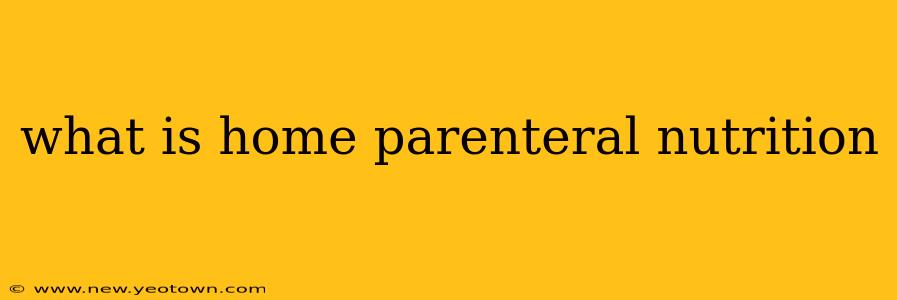Imagine a life where nourishing your body, a fundamental act of survival, becomes a complex and potentially life-threatening challenge. For individuals with certain medical conditions, this is a stark reality. Enter home parenteral nutrition (HPN), a revolutionary lifeline that delivers essential nutrients directly into the bloodstream, allowing people to thrive outside the confines of a hospital. This isn't just about survival; it's about living a full and vibrant life, despite significant medical hurdles.
Let's delve into what exactly HPN entails, exploring its intricacies and the profound impact it has on the lives of those who rely on it.
What are the conditions that require HPN?
Home parenteral nutrition is a specialized form of medical care reserved for individuals whose digestive systems are unable to absorb the nutrients they need to survive. A range of conditions can necessitate this life-sustaining treatment. These often include:
- Short Bowel Syndrome (SBS): This occurs when a significant portion of the small intestine is removed or damaged, rendering it incapable of absorbing sufficient nutrients. SBS is a frequent reason for resorting to HPN.
- Inflammatory Bowel Disease (IBD): Conditions like Crohn's disease and ulcerative colitis can severely compromise the gut's ability to absorb nutrients, making HPN a vital intervention.
- Intestinal Failure: This encompasses a variety of conditions where the intestines fail to function properly, leading to malnutrition and the need for intravenous nutrition.
- Congenital Anomalies: In some cases, individuals are born with conditions that prevent their digestive system from functioning correctly, making HPN essential from a young age.
- Cancer and its Treatment: Certain cancers and their treatments, such as chemotherapy or radiation, can significantly impair the digestive system's ability to absorb nutrients, often necessitating HPN.
How does HPN work?
HPN works by bypassing the digestive system entirely. A carefully formulated nutrient solution, meticulously crafted to meet the individual's specific needs, is administered intravenously through a central venous catheter – a thin, flexible tube inserted into a large vein. This solution contains all the essential nutrients the body needs, including carbohydrates, proteins, fats, vitamins, and minerals. The nutrients are delivered directly into the bloodstream, nourishing the body without requiring digestion.
What are the benefits of HPN?
The benefits of HPN extend far beyond simple sustenance. While it's a critical means of ensuring adequate nutrition, it also significantly impacts quality of life:
- Improved Nutritional Status: The most obvious benefit is the maintenance of optimal nutritional status, preventing malnutrition and its debilitating consequences.
- Increased Independence: HPN empowers individuals to manage their nutrition at home, reducing their dependence on hospital stays and enhancing their independence.
- Improved Quality of Life: By allowing individuals to live normal lives, free from the constraints of constant hospital visits, HPN improves overall quality of life, allowing them to pursue their passions and engage in social activities.
- Enhanced Growth and Development (in children): In children requiring HPN, the therapy is crucial for normal growth and development.
What are the potential risks and complications of HPN?
While HPN offers remarkable benefits, it's essential to acknowledge potential complications:
- Catheter-related infections: Infections at the catheter insertion site are a significant concern and require vigilant monitoring and meticulous hygiene practices.
- Blood clots: The risk of blood clots forming in the veins is increased with long-term intravenous access.
- Liver problems: Long-term HPN can sometimes strain the liver, necessitating close monitoring of liver function.
- Electrolyte imbalances: Careful monitoring and adjustments of the nutrient solution are necessary to prevent imbalances in electrolytes.
What is the difference between HPN and TPN?
Often, the terms HPN and TPN (total parenteral nutrition) are used interchangeably. However, the key distinction lies in the location of administration. TPN is a broader term referring to intravenous nutrient delivery, while HPN specifically denotes this delivery occurring at home, as opposed to in a hospital setting.
How is HPN administered at home?
The transition to home HPN is a carefully managed process. Individuals undergo comprehensive training to learn how to prepare and administer the solution safely and efficiently. Regular follow-up appointments with healthcare professionals ensure the continued safety and efficacy of the therapy. This team approach is crucial for the long-term success of HPN.
In conclusion, home parenteral nutrition represents a remarkable achievement in medical technology, offering a lifeline to individuals who would otherwise face severe nutritional deficiencies. It's a testament to the power of medical innovation to transform the lives of those affected by complex medical conditions, allowing them to live fuller, healthier, and more independent lives.

